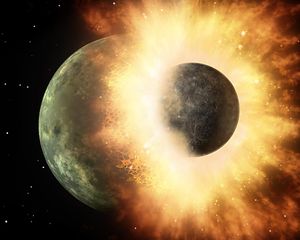Precambrian
The Precambrian consists of Earth's first three eons, extending from approximately 4.6 billion to 635 million years ago. The Precambrian eons are the Proterozoic (the last eon), the Archean, and the Hadean (the earliest point of Earth's history). The Precambrian covers 88% of Earth's history. The Phanerozoic eon, the time when complex life (e.g. fish, dinosaurs, plants, etc) truly comes into its own, only accounts for the most recent 12% of Earth's time since its formation 4.6 billion years ago. [1]
The Hadean

The Hadean begins with the formation of the Earth, 4.6 billion years ago, and lasts until approximately 4 billion years ago.[1] The planet's surface would have been mostly molten in the beginning, so there is very little evidence from this time period in the geologic record (Figure 1).[3] Most of the oldest rocks found tend to be between 2.5 and 3.8 billion years in age (placing them in the Archean eon) but one of the oldest rocks discovered to date contains 4.02 billion-year-old zircons (neosilicate minerals). These zircons were found in the Idiwhaa gneisses of the Acasta Gneiss Complex, from northwestern Canada. [4]
During this time the Earth's layers were becoming differentiated, establishing things like the abundance of elements in the different layers and the geothermal gradient.[5] The Earth was also facing frequent impacts from extraterrestrial objects. One of these objects was believed to be a planetoid the size of Mars (Figure 2). The resulting impact "splashed" material into outer space and, caught in Earth's gravitational pull, coalesced to form the Moon.[6]

The Archean
The Archean began 4 billion years ago and lasted until 2.5 billion years ago.[1] During the Archean, the Earth's crust cooled enough that young tectonic plates and oceans began to form. The first life on Earth was bacteria microfossils found during this eon (approximately 3.5 billion years ago). The atmosphere of Earth at this would have been inhospitable to most of today's organisms, though. It was rich in methane and ammonia plus other toxic gases.[5]
The Proterozoic
The Proterozoic began 2.5 billion years ago and lasted until approximately 541.0 million years ago.[1] The planet was cooling and the Proterozoic saw the formation of the first, stable, continental plates and the majority of Earth's supercontinents. Supercontinents occur when the majority of the Earth's landmasses come together as a single unit due to plate tectonics. Three of the largest supercontinents plus several smaller ones formed during this time. The first ice ages began in the early Proterozoic, resulting in the start of global cooling events.[3]
The Proterozoic also saw the development of the Archean bacterias and other single-celled organisms into more complex lifeforms. They developed into multicellular organisms, and perhaps even the first early animals by the end of the Proterozoic. More complex plants began to develop, as well. Oxygen began to increase suddenly and rapidly in the atmosphere. This is thought to have been caused by photosynthetic activities of cyanobacteria. Most bacteria at the time found oxygen to be lethal though, resulting in large-scale die-offs. This helped to pave the way for organisms that could tolerate oxygen and allowed them to develop.[8]
For Further Reading
References
- ↑ 1.0 1.1 1.2 1.3 1.4 International Commission on Stratigraphy."International Chronostratigraphic Chart v2018" Accessed Nov.8, 2018 [Online]. Available: http://www.stratigraphy.org/index.php/ics-chart-timescale
- ↑ WikiMedia Commons, "File: Earth formation.jpg". Accessed Dec.12, 2018. [Online] Available from: https://en.wikipedia.org/wiki/File:Earth_formation.jpg
- ↑ 3.0 3.1 Gradstein, F. M. "The Geologic Time Scale 2012". Volume 2. 1st ed. Amsterdam ; Boston: Elsevier, 2012.
- ↑ UJohnson, T. E., Gardiner, N. J., Miljković, K., Spencer, C. J., Kirkland, C. L., Bland, P. A., & Smithies, H. (2018). "An impact melt origin for Earth’s oldest known evolved rocks". Nature Geoscience, 11(10), 795.
- ↑ 5.0 5.1 University of California, Museum of Paleontology."The Archean Eon and the Hadean" Accessed Dec.12, 2018 [Online]. Available: http://www.ucmp.berkeley.edu/precambrian/archean_hadean.php
- ↑ . Mary Bagley. "Precambrian: Facts About the Beginning of Time" Accessed Dec.12, 2018 [Online]. Available: https://www.livescience.com/43354-precambrian-time.html
- ↑ WikiMedia Commons, "File:Artist's concept of collision at HD 172555.jpg". Accessed Dec.12, 2018. [Online] Available from: https://en.wikipedia.org/wiki/File:Artist%27s_concept_of_collision_at_HD_172555.jpg
- ↑ University of California, Museum of Paleontology."The Proterozoic Eon" Accessed Dec.12, 2018 [Online]. Available: http://www.ucmp.berkeley.edu/precambrian/proterozoic.php

